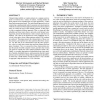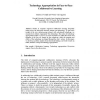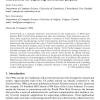894 search results - page 17 / 179 » Can we predict which groups of questions students will learn... |
MOBICOM
2006
ACM
14 years 21 days ago
2006
ACM
Characterizing mobility or contact patterns in a campus environment is of interest for a variety of reasons. Existing studies of these patterns can be classified into two basic a...
ECTEL
2006
Springer
13 years 10 months ago
2006
Springer
Studies in computer supported collaborative learning frequently under-expose the interaction between students and technology. To gain more insight in the way student groups interac...
ICS
2010
Tsinghua U.
14 years 4 months ago
2010
Tsinghua U.
Computation in the physical world is restricted by the following spatial locality constraint: In a single unit of time, information can only travel a bounded distance in space. A ...
ITS
2010
Springer
13 years 11 months ago
2010
Springer
The traditional, well established approach to finding out what works in education research is to run a randomized controlled trial (RCT) using a standard pretest and posttest desig...
IJMMS
1998
13 years 6 months ago
1998
controls, recoverability, and how strictly views should be shared between students. Teachers can also add structure to the group’s activities by setting the simulation environmen...



